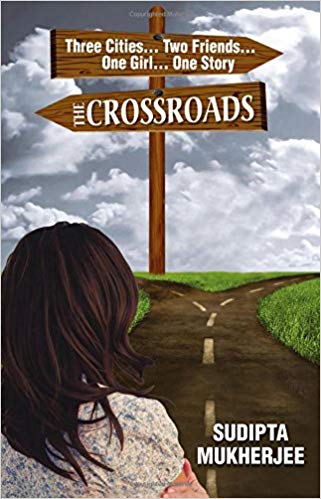


My enjoyment in reading the fiction, “The Crossroads”, by an Indian writer Sudipta Mukherjee was primarily governed by her use of the English language in an effective manner, especially in her narration and descriptive power of characterization. This is her maiden novel covering three cities, two friends, one girl and it is a one story. But what is the plot about? The blurb helps:
“The Crossroads is a story of Aparajita Basu, a girl from a humble household of Kolkata, who tears away from her family to settle her roots in America, with her childhood friend, Aniruddha. To Aparajita, he is everything she ever wanted. Love dwindles slowly. Fate turns in a blink. Disheartened, she returns, not to her hometown but to a different city, where she finds herself a stranger, Haunted by her disturbed thoughts, obsessed by that one name, she finds no escape… until she discovers herself, standing on a new crossroads. An ordinary girl, who loses herself to love. A lover, who turns out to be a betrayer. A friendship born on a stormy night. Wisdom bred out of miseries. A home coming that completes one full cycle.”
But simple or a triangle of love story it may seem, the richness lies in its craftsmanship.
The book is divided into three sections: Kolkatta, Pullman and Chennai. It runs to 386 pages that include a Prologue and an Epilogue. Published by Frog Books in Mumbai in 2015 it is priced at US $13
The book is dedicated to Brahma, Vishnu and Siva in the Sanskrit Sloka as follows: “Guru Brahma, Guru Vishnu, Guru Devo Maheshwara, Guru Sakshat, Para Brahma, Tasmai Shri Guruvay Namah”
The felicity of language is admirable for a maiden work. More than the meat in the novel the sheer poetry in prose entertains me ravishingly. The English is marvelous by any standards.
On pages 86-87 there is beautiful erotic writing too written from a feminine point of view.
Her novel is not merely a fiction but a study to be relished slowly and analyzed. It has many layers and nuances that have be analyzed as if for a thesis.
…
Let me now show you only a few passages from Chapter 22 only among the many I loved to relish and a few observations on the vitality of the authors fascinating expressions:


 க.நா.சு என்று அனைவராலும் அறியப்படும் க.நா.சுப்ரமண்யம் என்பதன் விரிவாக்கம் கந்தாடை நாராயணசாமி சுப்ரமண்யம். இவர் தன் விமர்சனங்களுக்காக அதிகமாக அறியப்பட்ட படைப்பாளர். இந்தியா முழுவதும் அறியப்பட்ட தமிழ் எழுத்தாளர். இவர் 1912ஆம் ஆண்டில் சனவரி 31 இல், தஞ்சாவூரை அடுத்த சுவாமி மலையில் (வலங்கைமானியில்) பிறந்தவர். இவர் அண்ணாமலை பல்கலைக்கழகத்தில் படித்துப் பட்டம் பெற்றவர். இவர் முழுநேர எழுத்தாளராகவே வாழ்ந்தவர். நாவல், சிறுகதை, கட்டுரை, கவிதை, மொழிபெயர்ப்பு, நாடகம், விமரிசனம் எனப் பல தளங்களில் தன் படைப்பாளுமையை வெளிப்படுத்தியர். ஐரோப்பிய படைப்புகளை மொழிபெயர்ப்புகள் மூலம் தமிழ் வாசகர்களுக்குப் பரவலாக அறியச் செய்த பெருமை க.நா.சு வுக்கு உண்டு. க.நா.சு வின் படைப்புலகத்தை அவரின் நூல்களின் வழி வெளிக்கொணர்வதே இக்கட்டுரையின் மையப்பொருளாகும். இருபதாம் நூற்றாண்டில் பல எழுத்தாளர்கள் இருந்தாலும் தன் படைப்புகளான கவிதைகள், சிறுகதைகள், நாவல்கள், நாடகங்கள், கட்டுரைகள், மொழிபெயர்ப்புகள் மற்றும் விமரிசனங்கள் என அனைத்து தளத்திலும் சிறந்து விளங்கிய க.நா.சுப்ரமண்யத்தின் படைப்புலகத்தை அவரின் வாழ்வு மற்றும் படைப்பின் வழி காண்பதே இக்கட்டுரையின் நோக்கமாகும்.
க.நா.சு என்று அனைவராலும் அறியப்படும் க.நா.சுப்ரமண்யம் என்பதன் விரிவாக்கம் கந்தாடை நாராயணசாமி சுப்ரமண்யம். இவர் தன் விமர்சனங்களுக்காக அதிகமாக அறியப்பட்ட படைப்பாளர். இந்தியா முழுவதும் அறியப்பட்ட தமிழ் எழுத்தாளர். இவர் 1912ஆம் ஆண்டில் சனவரி 31 இல், தஞ்சாவூரை அடுத்த சுவாமி மலையில் (வலங்கைமானியில்) பிறந்தவர். இவர் அண்ணாமலை பல்கலைக்கழகத்தில் படித்துப் பட்டம் பெற்றவர். இவர் முழுநேர எழுத்தாளராகவே வாழ்ந்தவர். நாவல், சிறுகதை, கட்டுரை, கவிதை, மொழிபெயர்ப்பு, நாடகம், விமரிசனம் எனப் பல தளங்களில் தன் படைப்பாளுமையை வெளிப்படுத்தியர். ஐரோப்பிய படைப்புகளை மொழிபெயர்ப்புகள் மூலம் தமிழ் வாசகர்களுக்குப் பரவலாக அறியச் செய்த பெருமை க.நா.சு வுக்கு உண்டு. க.நா.சு வின் படைப்புலகத்தை அவரின் நூல்களின் வழி வெளிக்கொணர்வதே இக்கட்டுரையின் மையப்பொருளாகும். இருபதாம் நூற்றாண்டில் பல எழுத்தாளர்கள் இருந்தாலும் தன் படைப்புகளான கவிதைகள், சிறுகதைகள், நாவல்கள், நாடகங்கள், கட்டுரைகள், மொழிபெயர்ப்புகள் மற்றும் விமரிசனங்கள் என அனைத்து தளத்திலும் சிறந்து விளங்கிய க.நா.சுப்ரமண்யத்தின் படைப்புலகத்தை அவரின் வாழ்வு மற்றும் படைப்பின் வழி காண்பதே இக்கட்டுரையின் நோக்கமாகும்.